|
| Big
Spring Ceremony |
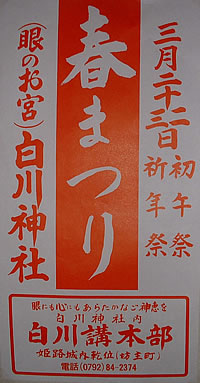 |
At Shirakawa Shrine,
known as the shrine for eyes, the Big Spring Ceremony is
held with the wish to be united with the Great Inari God
in the spring when everything blossoms. We will renew a strong
blessing to our eyes and hearts at this ceremony. At the
Hatsuuma Ceremony on March 22, people celebrate the advent
of the Great Inari God and pray for the health and safety
of worshipers and participants. At the Kinen Ceremony on
March 23, we pray for a good harvest, the prosperity of the
Royal Family, a prosperous continuity of our country, and
the safety of the people as well as the health of the worshipers
and participants.
[ Large
view ] 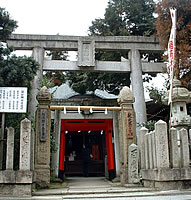 |
| [ Top ] |
Hana-Matsuri
(Flower Festival),
Camellia Exhibition & Shosha-Sakamoto Flea Market |
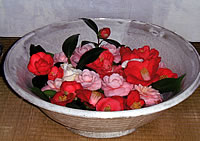
[ Large
view ] |
Hana-Matsuri,
is the birthday celebration of Gautama who started Buddhism.
On this day people worship Buddha who's images are on
a stage surrounded by colorful camellias, pouring
sweet tea on the top of the Buddha and wishing the participants
good health. Over
300 camellias in the temple welcome the visitors to this
event. Shosha-Sakamoto, where Amidaji Temple is located,
was the political and economic center of the Harima region
in the Muromachi Era (14th and 15th century), and was ruled
by the Akamatsu Family. Therefore, this area was well endowed
with many markets called Sakamoto-Waichi. To revive the prosperity
of this area, the flea-market is open at the same time as
the Hana-Matsuri and the camellia exhibition are held. |
| [ Top ] |
| Cherry-Blossom
- Drum Event |

[ Large
view ] |
Spring
at its best! “Himeji Castle Cherry-Blossom Viewing
and Drum Event” is held every year when the cherry
trees are in full bloom at Himeji Castle. Surrounded by approximately
1000 trees, chosen as one of the best 100 places for cherry
blossoms in Japan, 100 Koto (Japanese-style
harps) are played by women in Kimono, and you can enjoy this
event in a refined atmosphere.
You can enjoy stimulating Taiko drums at this
blossom-viewing event.
Cherry blossoms in the Nishinomaru Garden of the castle
are illuminated at night during the blossom-viewing events.
[ Large
view ] 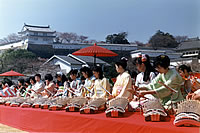 |
| [ Top ] |
| Otaue
Ceremony (Rice-Planting Ceremony) |
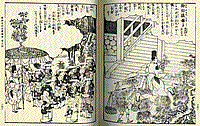
[ Large
view ]
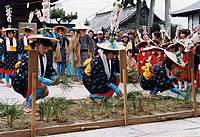
[ Large
view ]
|
The
Otaue Ceremony at Hiromine Shrine is held in hopes for a
good rice harvest and it is the most important ceremony among
the many rituals for agriculture. People were afraid of epidemics
and famine caused by insects that do harm to the rice plant.
So they have participated the ceremony to pray for a good
harvest and for a good life at the beginning of the rice-planting
season. Additionally they have sought fortunetelling about
the harvest for the coming year. At this ceremony a temporary
rice-field surrounded by wooden boards is made in front of
the shrine and it is divided into three sections for three
different rice groups depending on the harvesting time: early,
medium and late. Field workers, young rice plant carriers,
young female planters, umbrella carriers, drummers and flute
players are first purified by a priest. Then, field workers
prepare the field by using a wooden plow and young rice-plant
carriers throw the plants from their baskets into the temporary
field. Young girls who wear a hat with cherry blossoms start
planting the rice. During the ceremony, flutes and drums
are played while accompanied with a song. |
| [ Top ] |
| Kikoku
Ceremony (Good Rice Harvest Ceremony) |
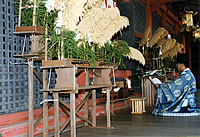
[ Large
view ]
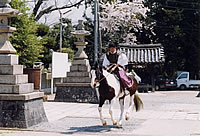
[ Large
view ]
|
Following
the Otaue Ceremony (Rice-planting ceremony) on April 3, the
Kikoku Ceremony (Good Rice Harvest Ceremony) is held on April
18 when the result of the fortunetelling of the rice crop
for the year is announced. During the first part of the ceremony
three groups of rice, divided as early-planting rice, middle-planting
rice and late-planting rice are offered to a God with flowers
and mochi-cakes with the presumption of a good rice crop
this year. Then the announcement of which rice this year
should be planted for a good harvest is made by a God. In
the second part, three horses with costumed riders run three
times in the grounds to brighten the area. This ceremony
has been handed down from since the Heian Era (for over 1000
years). |
| [ Top ] |
| Arts-n-Crafts
Fair |
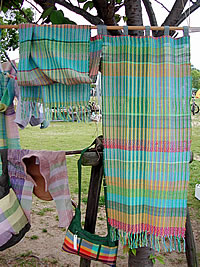
[ Large
view ] |
Artists
from all over the country come to this annual fair to show
and sell their works. Their works are composed from wood,
pottery, glass, textile and iron. More than 100 booths are
set up and live music is also performed.
[ Link ]
[ Large
view ] 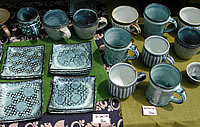 |
| [ Top ] |
| Onna
Matsuri (Women's Festival) |
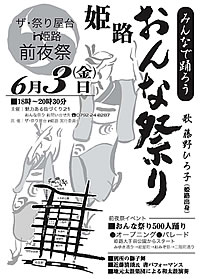
[ Large
view ] |
Over
500 women from kindergarten pupils to the eldery dance and
parade in the shopping streets with the song of 'Onna-Matsuri'
on the evening before 'The Matsuri- Yatai in Himeji'.
Photos:
[ 1 ]
[ 2 ]
[ 3 ]
[ Large
view ] 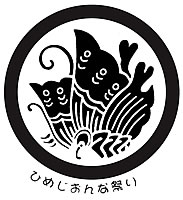 |
| [ Top ] |
| Matsuri-Yatai
in Himeji |
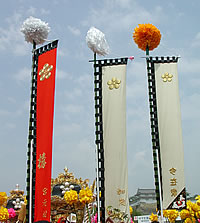
[ Large
view ] |
Himeji's
autumn festivals are known for their magnificence and soul-stirring
atmosphere as many men carry the well-decorated mobile shrines
on their shoulders and parade through their neighborhoods.
The Matsuri-Yatai in Himeji has been held since 2004 to show
the beauty of these splendid mobile shrines in front of the
beautiful Himeji Castle, a World Cultural Heritage.
[ Large
view ] 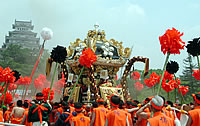 |
| [ Top ] |
| Yukata-Matsuri |
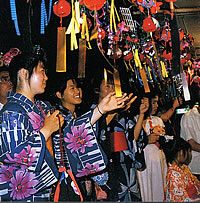
[ Large
view ] |
The Yukata-Matsuri (casual kimono festival) held June 22 and 23 was said to begin the biggest festival of Osakabe Shrine. People worshiped the local god of Himeyama at the Osakabe Shrine, and it was located where the castle is now for over 1000 years. Since Hideyoshi Toyotomi built the three-storied castle on the hill in the 16th century and Terumasa Ikeda constructed the present castle there in 1609, ordinary citizens, except samurai-class people, had not been able to visit and worship at the shrine. When Masamine Sakakibara, a lord of Himeji Castle, was ordered to move to Echigo (Niigata) about 260 years ago, he moved the shrine from the hill to downtown Himeji where everyone can visit it easily. He held the Moving God Ceremony on the summer solstice day, and the biggest festival of this shrine has been held on June 23 since then. During the Moving God Ceremony, citizens were allowed to wear their yukata (casual kimono) because they did not have enough money and time to make their formal kimono for the event. Citizens have celebrated the festival every year with their yukata, and so people call it Yukata-matsuri. The number of vendors around this event location is the biggest in Western Japan, and a great number of people participate in this festival. |
| [ Top ] |
| Summer
Purification Ceremony |
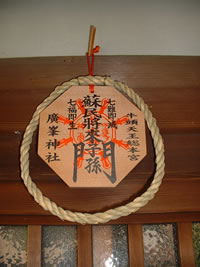
[ Large
view ] |
Twice
a year, at the end of the first and second half-year, we
have a custom to purge impurities that have accumulated in
the past six months. The June ceremony is called Nagoshi-no-harae,
summer purification, and the December ceremony is called
Toshikoshi-no-harae, year-end purification. On June 30, people
walk three times through a big thatched ring in front of
the shrine before praying there. You first walk through the
ring and make a left-turn and come back to the starting
point. Then you pass through the ring and make a right-turn
and come back to the same point. Last, you walk through the
ring toward the shrine. The "Bingo-no-kuni-fudoki" written
in the 8th century, describes an instance when Gozutenno,
the main god at Hiromine Shrine, said to his poor host, Somin-Shorai, "make
a thatched ring and carry it around your waist to avoid disease
in case an epidemic spreads throughout the country." Subsequently,
we believe that thatching protects us from evil.
[ Large view ] 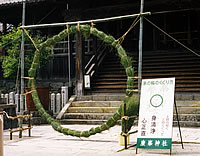 |
| [ Top ] |
| Ieshima-Tenjin Festival |
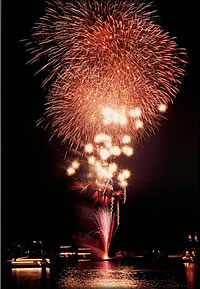
[ Large view ] |
Ieshima-Tenjin
Festival, held on July 24 and 25 every year, is the biggest
festival on Ieshima Shrine. This shine has a recorded history
of more than 1000 years. A traditional story tells of Michizane
Sugawara visiting the shrine during exile on his way to Kyushu.
Many seamen on the island worship at this shrine. This festival
is for safety on the sea and prosperity for the local people.
Two boats are put together, elaborately decorated, and equipped
with a stage for performing. On July 25 these dragon-headed
Danjiri boats sail energetically. Their ceilings are embellished
with the Ichimatsu pattern, and the edges of boats are skirted
with carved Ranma. There are many boats with banners where
the lion dance is performed while accompanied by flute, drums
and other musical instruments. The launching of Danjiri boats
is the highlight of this festival. The people of the island
conclude the festival on the night of the 25th with 1000
fireworks.
[ Large view ] 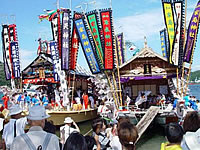 |
| [ Top ] |
| Offshore
Fireworks Event |
 |
The “Offshore
Fireworks Event” in late July is a part of the Himeji
Port Festival. Approximately 3000 fireworks light up the
night sky and fireworks called “Star Mines” are
launched on the surface waters of Himeji Port. |
| [ Top ] |
| Himeji
Castle Festival |
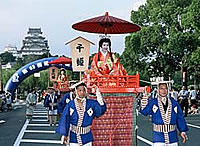 |
The “Himeji
Castle Festival” in early August is the most important
summer festival for people in the Himeji area. It begins
with “Takigi-Noh”, a Noh play performed while
accompanied by bonfire at night. The performance, with Himeji
Castle illuminated in the background, is filled with profound,
quiet elegance. On the following day many groups of people
walk in a parade. The selected “Queen of Himeji Castle” is
followed by marching bands and by people in historical costumes
traditionally worn for the princess’s wedding. Dance
groups, playing Banshu Ondo music, are the highlight of the
festival. |
| [ Top ] |
| Himeji Yosakoi Festival |
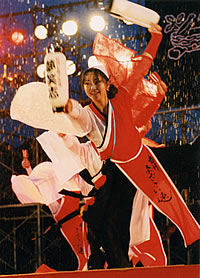
[ Large
view ] |
"Good
human kindness and love in Himeji" is a motto for this
event and it began with 30 interested people in August, 2000.
This annual event is to cheer up the city of Himeji with
two main themes: to foster the youth physically and mentally,
and to revitalize the shopping area. Every performer feels
happy to dance there and to be seen, and likewise the audience
enjoys their performance. Over 1500 energetic dancers present
their performance around the castle.
More photos: [ 1 ]
[ 2 ]
[ Large
view ] 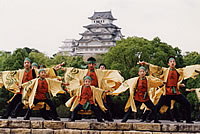 |
| [ Top ] |
| Himeji Castle Moon-Viewing Event |
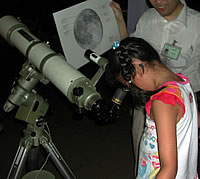
[ Large
view ] |
In
mid-fall this is the event to enjoy the beautiful moon with
Himeji Castle in the background. Koto-play, Japanese drums
and local dance are performed on a stage. Local sake and
sweets can be purchased there, and the areas for tea-ceremony
and for observing the moon are set up at the site.
More
photos: [ 1 ]
[ 2 ]
[ 3 ]
[ 4 ]
[ 5 ]
[ Large
view ] 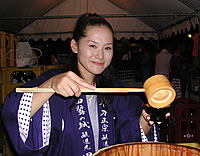 |
| [ Top ] |
| Nada
Kenka Matsuri |
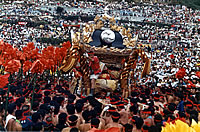 |
The “Nada
Kenka Matsuri” of the Matsubara
Hachiman Shrine on
October 14 and 15 is known nationwide for its magnificence
and the heroic performance of portable-shrine bearers. Participants,
with colorful bamboo poles, become excited and call out gallantly.
[ Large
view ] |
| [ Top ] |
| Lion
Dance |
 |
The “Lion
Dance of the Ohshio Tenmangu
Shrine” on October 14
and 15, an event handed down since the Kamakura period, features
8 lions performing brave dances to traditional music. |
| [ Top ] |
| Chrysanthemum Exhibition at Himeji Castle |
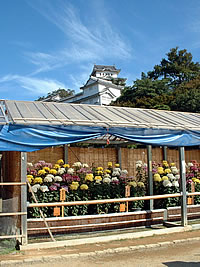
[ Large
view ] |
More
than 200 works of miniature
gardens, chrysanthemums and bonsai-styled
chrysanthemums, which are grown with utmost care by members
of the Himeji Chrysanthemum Association and chrysanthemum
lovers, are exhibited. Himeji Castle is the backdrop for
elegantly-blooming large chrysanthemums. You can enjoy viewing
this exhibit without entering the castle.
[ Large
view ] 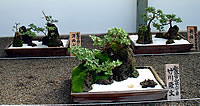 |
| [ Top ] |
| Lantern Festival |

[ Large
view ] |
The “Lantern
Festival of the Usuki Hachiman
Shrine” is a unique
event. Participants try to hit and take down a lantern on
the top of a 3-meter-high bamboo pole. This lantern fight
takes place in the evening of October 21, and on the following
day 18 portable shrines arrive for this festival. |
| [ Top ] |
| Japan Pottery Fair |
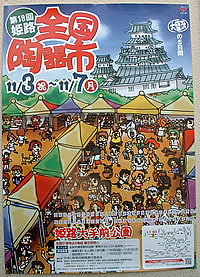
[ Large
view ] |
You
can see pottery from all over Japan. Over 200,000 ceramic
items from over 30 kilns including famous Shigaraki, Echizen
and Kutani are exhibited and sold at this fair. Ceramics
from the Sohma kiln of Fukushima prefecture and from the
Tsuboya kiln of Okinawa are shown there, too. It is one of
the biggest pottery fairs in Western Japan. Areas for Tea
Ceremony and local delicacies are also set up at this fair.
More
photos: [ 1 ]
[ 2 ] [ 3 ]
[ Large
view ] 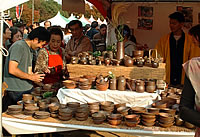 |
| [ Top ] |
| Kokoro-no-Matsuri
(Festival of Heart) |
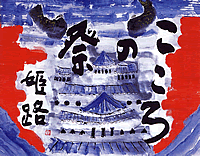
[ Large
view ] |
On
November 11 from 10AM to 4PM, citizens of Himeji voluntarily
open their houses, studios, work-places, temples and shrines.
You may find hidden treasure and feel the warmth of people
in Himeji, visiting these places where we usually are not
able to see and talking to the people there. About 10,000
people tour around the city through this event, and over
50 places throughout the city are open to the public every
year.
More photos: [ 1 ] [ 2 ]
[ Large
view ] 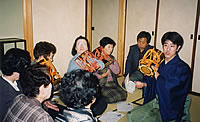
|
| [ Top ] |
| Ohashira-sai
(Ceremony of Sacrid Pole) |
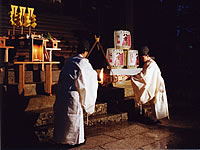
[ Large
view ]
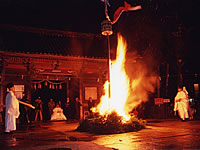
[ Large
view ]
|
Hiromine
Shrine was a center of the Yin-Yang School. This ceremony
is held on November 15 which is regarded as the best day
in the year in the Yin-Yang philosophy. It is a ceremony
in hopes that the sun will give us enough light and energy
in the coming year for a good harvest and to pray for good
fortune and happiness. This ceremony has more than a 1000-year
history.
A sacred 5-meter-high pole is erected in the early morning
on the day in front of the main hall of the shine. Then
12 wooden boards which represent each direction are tied
on top of the pole, and we pray for God’s visit to
the pole from above.
After the ceremony at the main hall of the shine, a fire
will be ignited at the bottom of the pole. The direction
in which the pole has fallen will be the one people should
be careful of after the next Chinese New Year.
November 15
4PM: Ceremony at the main hall
5PM: Put the fire to the Sacred Pole
|
| [ Top ] |
| Japan
Kite Festival |
 |
The “Japan
Kite Festival” opens on Adults’ Day. Approximately
800 kites of different kinds are flown, and this event is
the biggest one of it type in Western Japan. |
| [ Top ] |
| Demon
Expulsion Ceremony |
 |
The “Demon
Expulsion Ceremony” at Engyouji Temple of Shosha and
at Zuiganji Temple of Masui is performed at the beginning
of the year with a wish for a good harvest and prosperous
business. Red
and blue demons, carrying fire and swords,
dance magnificently.
[ Large
view ]
[ Large
view ] 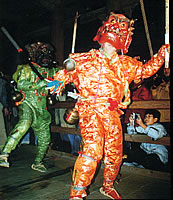 |
| [ Top ] |
| Setsubun
Ceremony |
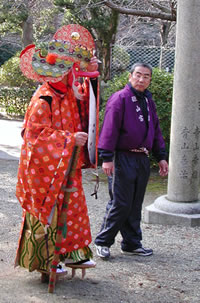
[ Large
view ] |
At Himeji Shrine, the Setsubun
Ceremony (Ceremony on the day before the first calendar day)
is held on February 3 every year. A fire is lit in front
of the main hall of the shrine at 13:30. The ceremony begins
at 14:00. A Red Demon, Blue Demon and Child Demons walk around
the shine. At the stage a dance by demons and other dances
are performed. In the main hall the Shinto ceremony is held.
At 15:30 soybeans are thrown by the priest and chosen citizens,
shouting "Demons out! Good luck in!"
More photos: [ 1 ] [ 2 ]
[ Large
view ] 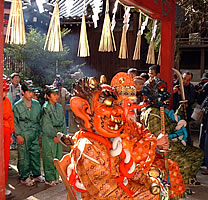 |
| [ Top ] |
| Goma (Holy Fire) Ceremony |
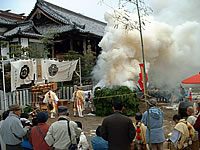
[ Large view ] |
For spiritual purification, holy wood is burned in front of the main God, Gozu-Tennoh, at Hiromine Shrine. This wood is regarded as human worries and misfortune, and the fire is symbolized as the wisdom and the truth. Participants can pray for healthy and safe lives by walking on the burned wood embers with their bare feet at the end of the ceremony.
More photos: [ 1 ] [ 2 ] [ 3 ]
[ Large
view ] 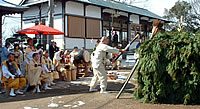 |
| [ Top ] |
| Yakujin
Ceremony (Purifying evil spirits) |
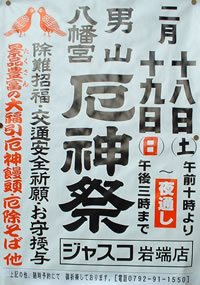 |
Hondawake-no-mikoto
was initially recognized at Otokoyama Hachiman Shrine, and has been worshiped
as a guardian god by the successive lords of the Himeji Castle.
Local supporters of this shrine continue the ancestral practice
of worship, which has been part of their history and tradition
for over a few hundreds years. Supporters hold a ceremony
to pray for world peace, prosperity for the local area, prevention
of bad luck, and family safety. This purifying ceremony is
the biggest in this area, and throughout the night visitors
keep coming. A sacred bonfire is made, and you can participate
in a lottery, manju-cakes and soba-noodles. The critical
ages for men are 24,40,41,42,60, and for women 18, 31,32,33,60.
More photos: [ 1 ] [ 2 ] [ 3 ]
[ Large
view ] 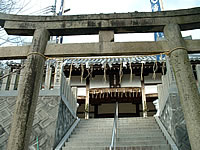 |
| [ Top ] |

